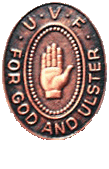
|
|
 |
|
|



 |
The 36th Brigade U.V.F |
 |
|
In October, 1915 after several months of preparation in England, men of the 36th (Ulster) Division sailed across the Channel and began to disembark in France. The soldiers, drawn from all parts of the nine counties of Ulster, had previously trained at Finner Camp in Donegal, Ballykinlar in County Down, and the Clandeboye Estate near Bangor. All were volunteers with an overwhelming majority of them in their late teens and early twenties and, while many perhaps sought adventure and a chance to see some of the world beyond the confines of their own home towns and villages, they believed absolutely that their cause in going to war to free France and Belgium from German oppression and invasion was just and honourable.
During the next winter and spring they learnt their combat and trench skills in the quieter regions of the Western Front before moving, in June, 1916, to take over their allotted areas on either side of the River Ancre and west of the village of Thiepval in preparation for the forthcoming Battle of the Somme which started on 1st July, 1916. For the British, Commonwealth, and Empire soldiers the outcome on that day was little short of a massacre. The Ulster Division, which gained a few hundred yards of ground from Thiepval Wood up the hill towards the dauntingly fortified Schwaben Redoubt, suffered some five and a half thousand casualties - out of a total divisional complement of ten or eleven thousand men. (In writing of "casualties" it is a generally accepted assumption that one out of every three was killed or died of wounds later). Unable to advance or retreat, and impossible to reinforce because of unrelenting German shell, and machine-gun fire, those soldiers in the redoubt and elsewhere in no-man's-land held on until night gave them cover to slip back to the precarious safety of their own lines. The next day the division was withdrawn from the front and moved to the area around St. Omer where it regrouped, received large numbers of fresh soldiers to replace those killed or wounded, and made ready for its next engagement - the Battle of Messines.
The small town of Messines lies at the southern end of a low, rounded ridge which stretches eight kilometres northwards towards Ypres. The ridge overlooks the flat Flanders Plain and, in 1917 in the hands of the Germans, it dominated the southern sector of the Ypres Salient held by the British . Its capture was vital if the commander-in-chief's (Field Marshal Haig) strategic attack eastwards out of the Salient was to succeed. The 36th Division joined the Second Army under General Plumer - a senior officer old-fashioned in appearance but with the deserved reputation both for meticulous battle preparation, and, in what had become a war of attrition, a keen regard for the saving of the lives of the men under his command. On a frontage of about 1,200 yards the Ulstermen took position south-west of the heavily fortified village of Wytschaete and, with the 16th (Irish) Division on its left, prepared for the day of attack - 7th June. At 3.10 a.m., with a roar clearly heard in London, nineteen monstrous British mines containing a total of 600 tons of high explosives were detonated under the defenders on the ridge. Beneath an intense artillery barrage the men of Second Army attacked the dazed and demoralised Germans and, by mid- afternoon, the entire ridge was in British hands. Wytschaete had held out for some time but after a fierce struggle it was captured by the combined efforts of the Irish and Ulster Divisions. After its success at Messines the 36th was withdrawn for rest and to prepare for its next battle.
Perhaps even more than the "The Somme", "Ypres" is a name which recalls all the waste of life, horror, and squalor of the Great War. The old walled Belgian town of Ypres is situated about forty miles east of Calais and throughout World War One it was defended by the indefatigable bravery of British soldiers and the obstinacy of their high command. On a shallow plain which barely rises above sea level, the clay soil of the land was drained by an intricate network of ditches; while to the east, north, and south a series of low ridges overlooked and commanded the town. From November, 1914 the Germans held the ridges and by July, 1917 the British "Salient" extended eastwards in an arc of about two to three miles in depth. Able to see almost every movement in the Salient and the town itself, the Germans had shelled the area continuously for years until all buildings were reduced to unrecognisable rubble and every field into an impassable quagmire pitted with millions of overlapping shell holes always filled with stinking liquid mud and often the decomposing remains of animals and the occasional bodies of dead soldiers. It was through, and then out of, this area that Haig intended to make a massive and war-winning attack striking eastwards from Belgium and towards Germany. The implementation of the plan was given to Fifth Army, commanded by General Gough who, unlike Plumer, had a reputation for poor staff work and a lesser regard for the care and safety of his men. In early July the Ulster Division moved near to St. Omer again and into the command of Fifth Army. The Battle of Third Ypres started on 22nd July when 3,091 British guns began a bombardment of the German positions which lasted until 31st July by which time some four and a quarter million shells had been fired. Then, at 3.50 a.m., in torrential rain twelve divisions made their attack on an eleven-mile wide front. Initially, on the left, some gains were made but on the right the attack slithered quickly to a halt. Thus things remained, for in the rain, which continued unabated day after day, neither man nor animal nor tank could move.
The 36th had been kept back from the original assault so that it could be used at a later date. But in the area north-east of Ypres and near the village St. Julien the division there was so badly battered and its soldiers so tired that it was decided to withdraw them and replace them much earlier than expected with the Ulster Division. This was accomplished in the rain and mud of the night of 2nd August and completed by the early hours of the next morning. There they existed for another fourteen days where all were soaked by the continual rain and suffered from a lack of food, of heating, and of drinkable water. Lying in trenches which were little more than watery scratches scooped out of the morass and feebly protected by sandbags filled with mud, the soldiers endured perpetual shelling and small arms fire. It was out of these conditions that, with the 16th (Irish) Division on its right, they were ordered to make an attack on 16th August in what has become known as the Battle of Langemarck. The Ulster Division was to advance about two and a quarter miles to reach its objective - an imaginary "Red Line". At 4.45 a.m. the men left their trenches but: pounded by high-explosive, shrapnel, and gas shells; ravaged pitilessly by machine-gun fire from impregnable concrete pill boxes protected by barbed wire entanglements; saturated by the rain; lost in a featureless landscape; and encumbered by the clinging mud: only a little ground on the left was gained, and by nightfall most of those still alive were back where they had started. That any progress at all was made is a tribute to the bravery and determination of the men, for the ambitious plan, conceived in the comfort of a distant headquarters, defied reality and was fatally flawed. In the dreadful conditions of the battlefield the British artillery's preliminary barrage and its subsequent "creeping" covering fire, which went far ahead of the attackers, were ineffective; and a few supporting tanks, bogged down in the impassable mire, never appeared. Furthermore, a weary division which had already sustained some 2,000 casualties due to enemy action during the previous two weeks, should never have been ordered to attack in the face of such overwhelmingly adverse odds.
For the capture of a few worthless yards of mud the attack resulted in 58 officers and 1278 men being gassed or wounded. During its sixteen days in the line, from 2nd to 18th August, the Division suffered the total loss of 144 officers and 3,441 men either killed, wounded or missing. The 16th (Irish) Division suffered grievously also, and together the two division suffered about 7,800 casualties - amounting to perhaps 50% of their original numbers. However, the efforts and sacrifices of the men were not enough for 5th Army's Commanding General; for Haig confided to his diary that Gough, 'was not pleased with the action of the Irish divisions .... They seemed to have gone forward but failed to keep what they had won .... The men are Irish and apparently did not like the enemy's shelling.' The pitiful tragedy of "Third Ypres" continued its bloody course until, on 4th November, the battle ended when the Canadians captured the muddy mound which had once been the village of Passchendaele - a name now associated irrevocably with the battle and which, perhaps, recalls more poignantly the sorrows of the men who fought there. After Langemarck the Division was withdrawn to rest and to receive reinforcements. It did not, however, ever have the same character again for most of its original men had been lost in the everyday hazards of war, and in the Battles of The Somme, Messines, and Passchendaele. Many of the recruits which filled the empty ranks were from diverse other parts of the British Isles - often young conscripts aged about nineteen or twenty. Nevertheless, the division still had a significant part to play in many of the remaining battles and campaigns of the War such as: The Battle of Cambrai in November, 1917; the German Spring Offensive of 1918, and its advance through Belgium during the War's final hundred days. Everywhere it fought it acquitted itself with courage and fortitude and by 11th November, 1918, nine Victoria Crosses and a multitude of other gallantry medals had been awarded to the doughty men of the 36th (Ulster ) Division.
On page 388 of his book he records these observations on the Battle of Langemarck: THE IRISH AT YPRES, 1917 The story of the two Irish Divisions, the 36th Ulster and 16th (Nationalist), in their fighting on August 16th, is black in tragedy. They were left in the line for sixteen days before the battle, and were shelled and gassed incessantly as they crouched in wet ditches. Every day groups of men were blown to bits, until the ditches were bloody and the living lay by the corpses of their comrades. Every day scores of wounded crawled back through the bogs, if they had the strength to crawl. Before the attack on August 16th the Ulster Division had lost nearly 2,000 men. Then they attacked and lost 2,000 more and over 100 officers. The 16th Division lost as many men before the attack and more officers. The 8th Dublins had been annihilated in holding the line. On the night before the battle hundreds of men were gassed. Then their comrades attacked and lost over more and 162 officers. All the ground below two knolls of earth called Hill 35 and Hill 37, which was defended by German pill-boxes, called Pond Farm and Gallipoli, Beck House and Borry Farm, became an Irish shambles. In spite of their dreadful losses the survivors in the Irish battalions went forward to the assault with desperate valour on the morning of August 16th, surrounded the "pill-boxes," stormed them through blasts of machine-gun fire, and towards the end of the day small bodies of these men had gained a footing on the objectives which they had been asked to capture, but were then too weak to resist German counter-attacks. The 7th and 8th Royal Irish Fusiliers had been almost exterminated in their efforts to dislodge the enemy from Hill 37. They lost 17 officers out of 21, and 64 per cent. of their men. One company of 4 officers and 100 men ordered to capture the concrete fort known as Borry Farm, at all cost, lost 4 officers and 70 men. The 9th Dublins lost 15 officers out of 17, and 66 per cent. of their men.
IN FLANDERS FIELD In Flanders field the poppies blow We are the Dead. Short days ago Take up our quarrel with the foe:
|